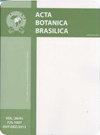巴西南部南里奥格兰德州最北端海岸平原两个巴西大西洋雨林沉积剖面中的被子植物花粉粒。第二部分
IF 1.1
4区 生物学
Q4 PLANT SCIENCES
引用次数: 0
摘要
南大德州(RS)位于巴西最南端,位于南美洲热带和亚热带之间的过渡区域,在过去一千年中经常受到气候和植被波动的影响。沉积物中保存的孢芽状体揭示了该地区的源生物及其各自的地质环境,为该地区的古环境重建提供了很好的研究材料。本研究旨在为RS海岸平原第四纪沉积物中保存的孢粉学参考资料提供古环境重建研究的参考资料。本文对位于RS海岸平原最北端Torres市的Pirataba森林剖面(29°15′S 49°51′W)和Faxinal森林剖面(29°21′S 49°45′W)的29个被子植物类群的花粉进行了分类描述,并结合生态资料和花粉显微照片进行了分类描述。这个参考材料,连同在两个沉积剖面中发现的其他地貌,是我们根据气候和植被动态研究巴西南部过去一千年古环境的基础。本文章由计算机程序翻译,如有差异,请以英文原文为准。
Angiosperm pollen grains in sedimentary profiles from two Brazilian Atlantic rainforests, northernmost coastal plain from Rio Grande do Sul, southern Brazil. Part II
The state of Rio Grande do Sul (RS) is located in the extreme south of Brazil, within a transition region between the tropical and subtropical zones of South America that has been frequently affected by fluctuations in climate and vegetation over the last millennia. Palynomorphs preserved in sediments have provided excellent study material for paleoenvironmental reconstitutions of this region, as they reveal the source organisms and their respective environments over geological time. The present study was conducted to provide additional palynological reference material preserved in Quaternary sediments from the RS coastal plain for paleoenvironmental reconstruction studies. Here, we present taxonomic descriptions of pollen from 29 angiosperm taxa extracted along two Quaternary sedimentary profiles: the Pirataba forest profile (29° 15’ S 49° 51’W) and the Faxinal forest profile (29° 21’ S 49° 45’ W), Torres municipality, in the extreme north of the coastal plain of RS. Ecological data and pollen photomicrographs accompany the taxonomic descriptions. This reference material, together with the other palynomorphs found in the two sedimentary profiles, was the basis for our study of paleoenvironments from the last millennia in southern Brazil, according to the dynamics of climate and vegetation.
求助全文
通过发布文献求助,成功后即可免费获取论文全文。
去求助
来源期刊

Acta Botanica Brasilica
PLANT SCIENCES-
CiteScore
2.30
自引率
9.10%
发文量
32
审稿时长
6-12 weeks
期刊介绍:
Experimental, theoretical and applied papers on all aspects of plant (including algae) and fungi biology are welcome. The submitted manuscript or its essential content must not have been published previously or be under consideration for publication elsewhere. Contributions should be substantial, written in high-quality English and show general interest. We expect that the submitted manuscript presents a great novelty in Botany, and this should attract a wide audience. Considering this, case studies are only considered if the narrative and implications are provided to be of general interest. Thus, manuscripts that report aspects of local interest are discouraged unless the implications of the findings are wide-reaching. Manuscripts with agronomic subjects are expected to contain a substantial amount of basic plant biology. Please see below some details for specific area.
 求助内容:
求助内容: 应助结果提醒方式:
应助结果提醒方式:


